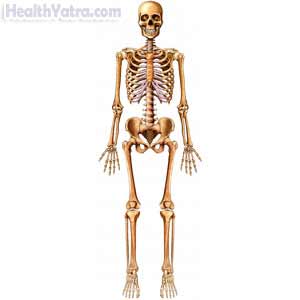تعريف
A fracture is a break in any bone in the body. Fractures are usually caused by trauma, such as falls, twists, blows, or collisions. There are different kinds of fracture:
- The bone may be fractured but stable (simple fracture).
- Bone fragments may be sticking through the skin (open).
Fractures may also be described as:
- Chip (avulsion fracture)—A small piece of bone is broken away from the main bone.
- Compression—The bone is compressed together (such as, vertebrae).
- Comminuted—The bone is in pieces.
- Greenstick—One side of the bone is broken and the other side is bent but not broken.
- Intra-articular—The joint is affected.
- Transverse—The bone is broken in a horizontal line that is perpendicular to the surface of the bone cortex.
- Oblique—The bone is broken in a line that is less than a 90° angle to the surface of the bone cortex.
- Spiral—The line of the fracture forms a spiral.
- Stress—A thin fracture line occurs due to overuse rather than a single traumatic incident.

أسباب
Fractures are caused by trauma to the bone. Trauma includes:
- السقوط
- التقلبات
- ضربات
- الاصطدامات
Trauma is a physical force applied to the bone that the bone cannot withstand. Stronger bones can withstand more physical force than weaker bones.
عوامل الخطر
A risk factor is something that increases your chance of getting a disease or condition. Risk factors for a fracture include:
- التقدم في السن
- Postmenopause
- انخفاض كتلة العضلات
- Osteoporosis—decreased bone mass which weakens bones (can affect men and women)
- Certain congenital bone conditions (rare)
- Taking glitazones (medication used to treat type 2 diabetes)
- Accidents or violence
الأعراض
Symptoms of a fracture include:
- Pain, often severe (primary symptom)
- Instability of the area around the break
- Inability to use the limb or affected area normally (may be full or partial restriction in movement)
- Swelling or bruising caused by the bleeding from the bone and surrounding tissues
- Numbness caused by damage to a nearby nerve (rare)
- Fainting or even shock (rare–only in severe trauma)
التشخيص
The doctor will ask about your symptoms and how you injured yourself. The doctor will examine the injured area.
قد تشمل الاختبارات ما يلي:
- X-rays—to look for a break in the bone
- CT scan—uses computerized x-rays to make pictures of structures inside the body
- MRI scan—uses a strong magnetic field and radio waves to make pictures of structures inside the body
- Bone scan—typically used to look for stress fractures
العلاج
Treatment involves:
- Putting the pieces of bone together (may require anesthesia and/or surgery)
- الحفاظ على القطع معًا بينما يشفي العظم نفسه
Devices that can hold a bone in place while it heals include:
- الجبيرة (يمكن استخدامها مع أو بدون جراحة)
- Metal pins across the bone with a frame holding them outside the bone (requires surgery)
- صفيحة معدنية بها براغي (تتطلب عملية جراحية)
- المسامير وحدها (تتطلب عملية جراحية)
- قضيب أسفل منتصف العظم (يتطلب عملية جراحية)
Healing and Rehabilitation
Healing time ranges from three weeks for a simple finger fracture to many months for a complicated fracture of a long bone. All fractures require rehabilitation exercises to regain muscle strength and joint motion.
المضاعفات المحتملة
- Delayed union—It takes longer than usual to heal, but does heal.
- Nonunion—The bone does not heal and needs some special treatment.
- Infection—This is more likely to happen after an open fracture or surgery.
- Nerve or artery damage—This usually occurs as a result of severe trauma.
- Compartment syndrome—Severe swelling in the spaces of the limbs that causes damage to body tissues.
- Late arthritis—This may happen if the surface of a joint is badly damaged.
If you are diagnosed with a fracture, follow your doctor’s instructions.
الوقاية
You can reduce your chances of getting a fracture:
- Avoid putting yourself at risk for an accident or other trauma to the bone.
- اتباع نظام غذائي غني بالكالسيوم وفيتامين د.
- Do weight-bearing exercise regularly to build and maintain strong bones.
- Do strengthening exercises regularly to build strong muscles and prevent falls.
- Patients with osteoporosis may benefit from bisphosphonate medications.
